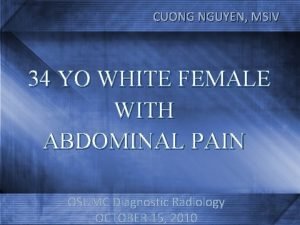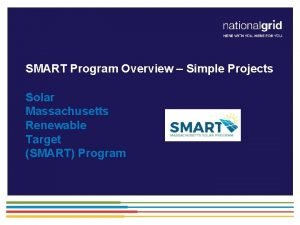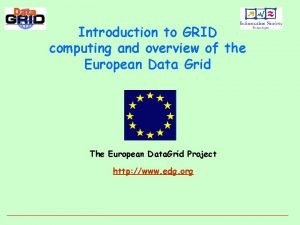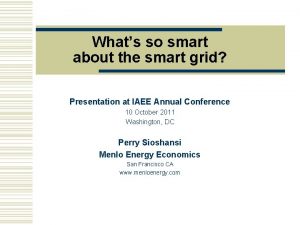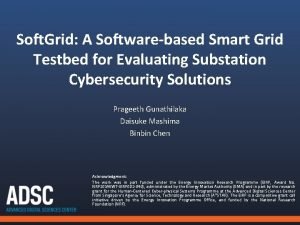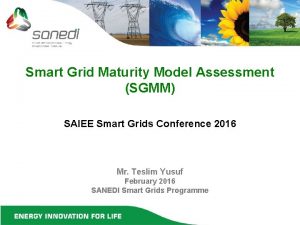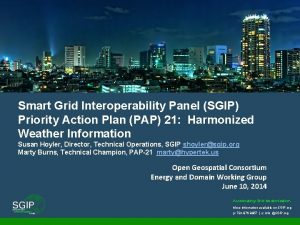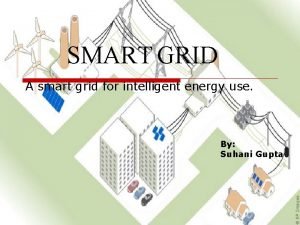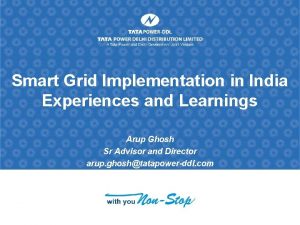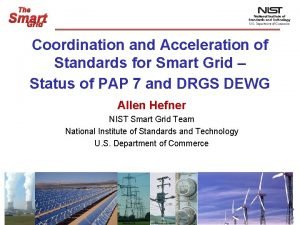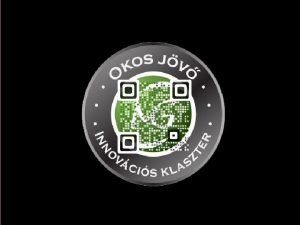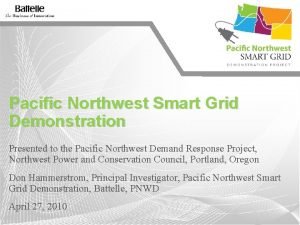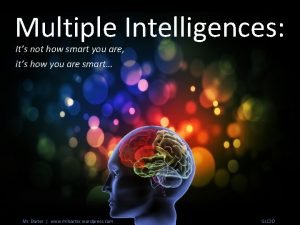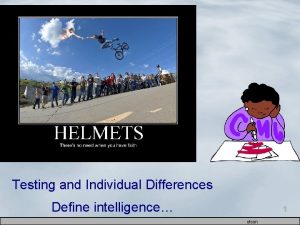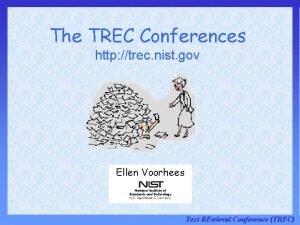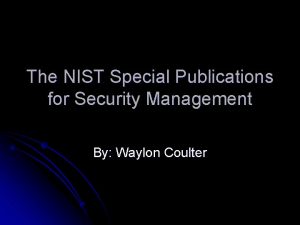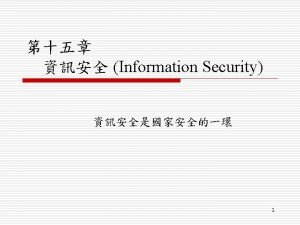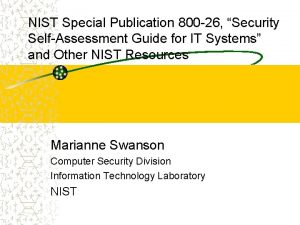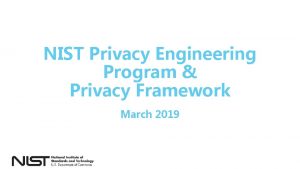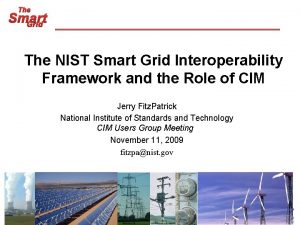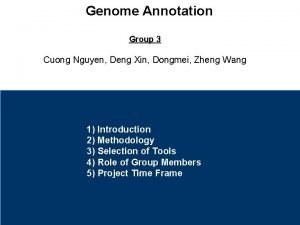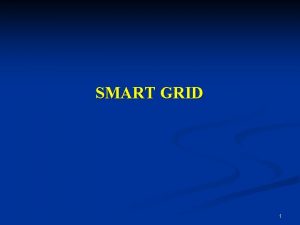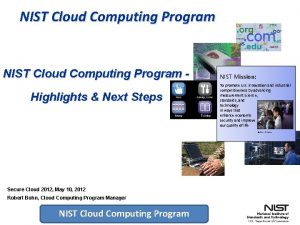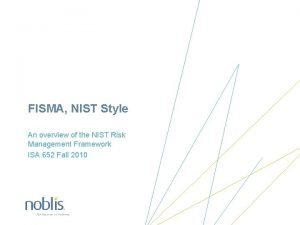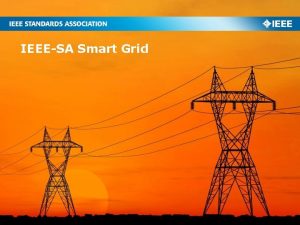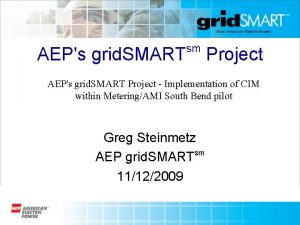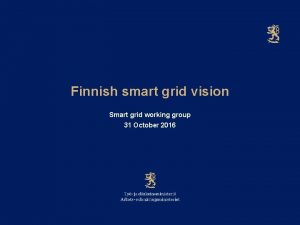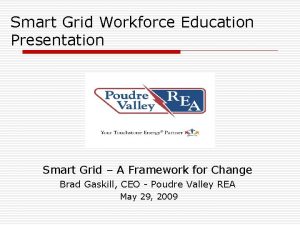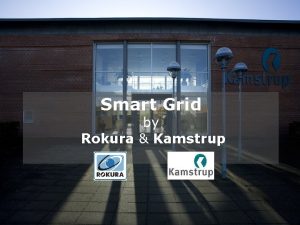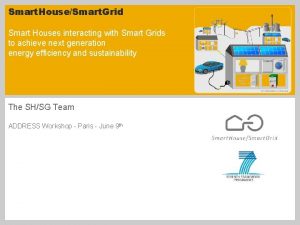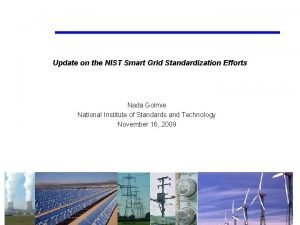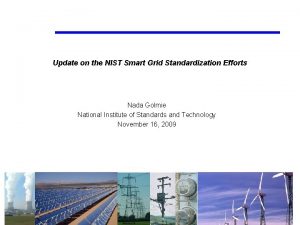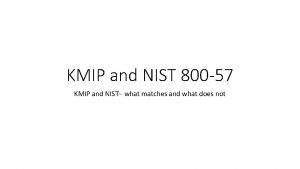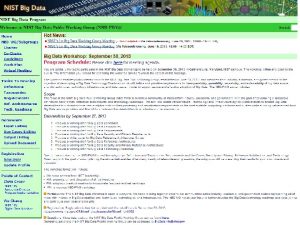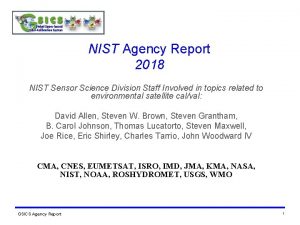Overview of NIST Smart Grid Program Cuong Nguyen








































- Slides: 40

Overview of NIST Smart Grid Program Cuong Nguyen Smart Grid and Cyber-Physical Systems Program Office Engineering Laboratory 44 th Meeting of the APEC Energy Working Group Washington, DC 6 November 2012

NIST Bird’s eye view The National Institute of Standards and Technology (NIST) is where Nobel Prizewinning science meets real-world engineering. Courtesy HDR Architecture, Inc. /Steve Hall © Hedrich Blessing With an extremely broad research portfolio, world-class facilities, national networks, and an international reach, NIST works to support industry innovation – our central mission. G. Wheeler 2

NIST’s Mission To promote U. S. innovation and industrial competitiveness by advancing measurement science, standards, and technology in ways that enhance economic security and improve our quality of life. 3

G. Hooijer/shutterstocom D. Stork/shutterstock. com NIST research has a broad impact 06 photo B. Gardner Improves public safety and security Facilitates trade and fair commerce Advances manufacturing and services Improves quality, ensures uniformity 4

NIST Research Focus Areas Energy Teb. Nad Healthcare Y. Arcurs Information Technology and Cybersecurity Environment S. Bonk designersart Physical Infrastructure Manufacturing 5 Fotocrisis Jovan Nikolic All photos courtesy Shutterstock. com

The Electric Grid “The supreme engineering achievement of the 20 th century” - National Academy of Engineering 6

The Electric Grid 100 Years Ago It’s not too different today! Wall Street, 1913 Edison Pearl Street Station, 1882 7

Not Quite True… There have been many innovations… High voltage transmission SCADA Phasor measurement units Power electronics 8

…Grid Architecture is Much the Same One-way flow of electricity • Centralized, bulk generation, mainly coal and natural gas • Responsible for 40% of human-caused CO 2 production • Controllable generation and predictable loads • Sized for infrequent peak demand – operates at 50% capacity • Limited automation and situational awareness • Lots of customized proprietary systems • Lack of customer-side data to manage and reduce energy use 9

Grid Requirements • Ubiquity • Affordability • Reliability – – Capacity Availability Resiliency Quality • Clean 10

What is the Smart Grid? The Smart Grid integrates information technology and advanced communications into the power system in order to: • Increase system efficiency and cost effectiveness • Provide customers tools to manage energy use • Improve reliability, resiliency and power quality • Enable use of innovative technologies including renewables, storage and electric vehicles 11

Enabling Greater Use of Renewables • Electricity generation accounts for 40% of human-caused CO 2 • Greater use of wind and solar requires more dynamic grid control and storage 12

Enabling Reduced Dependence on Oil • Idle capacity of the power grid could supply 70% of energy needs of today’s cars and light trucks • Displace half of US oil imports • Reduce CO 2 20% • Reduce urban air pollutants 40%-90% • Batteries in EVs could provide power during peak demand Source: Southern California Edison 13

Smart Grid – A U. S. National Policy • “It is the policy of the United States to support the modernization of the Nation's electricity [system]… to achieve…a Smart Grid. ” - Congress, Energy Independence and Security Act of 2007 http: //www. whitehouse. gov/ostp 14

Standards – Key Aspect of US Policy The Energy Independence and Security Act gives NIST “primary responsibility to coordinate development of a framework that includes protocols and model standards for information management to achieve interoperability of smart grid devices and systems…” • Congress directed that the framework be “flexible, uniform, and technology neutral” • Use of these standards is a criteria for federal Smart Grid Investment Grants • Input to federal and state regulators 15

NIST Roles in the Smart Grid • Measurement research – Metering – Wide area monitoring (synchrophasors) – Power conditioning – Building energy management – Electricity storage • Standards (EISA role) – Interoperability – Cybersecurity 16

Smart Grid Evolution Dynamic pricing High use of variable renewables Energy management systems Distributed generation and microgrids Distributed storage Electric Bidirectional vehicles metering Ubiquitous networked sensors Smart meters and real time usage data Smart appliances 17

Stakeholders in the Process 1 2 3 4 5 6 7 8 9 10 11 Appliance and consumer electronics providers Commercial and industrial equipment manufacturers and automation vendors Consumers – Residential, commercial, and industrial Electric transportation industry Stakeholders Electric utility companies – Investor Owned Utilities (IOU) Electric utility companies - Municipal (MUNI) Electric utility companies - Rural Electric Association (REA) Electricity and financial market traders (includes aggregators) Independent power producers Information and communication technologies (ICT) Infrastructure and Service Providers Information technology (IT) application developers and integrators 12 Power equipment manufacturers and vendors 13 Professional societies, users groups, and industry consortia 14 R&D organizations and academia 15 Relevant Government Agencies 16 Renewable Power Producers 17 Retail Service Providers 18 Standard and specification development organizations (SDOs) 19 State and local regulators 20 Testing and Certification Vendors 21 Transmission Operators and Independent System Operators 22 Venture Capital 18

Standards Come from Many Developers International Global Consortia Regional and National 19

NIST Three Phase Plan PHASE 1 Identify an initial set of existing consensus standards and develop a roadmap to fill gaps 2009 PHASE 2 Establish public/private Interoperability Panel to provide ongoing recommendations for new/revised standards PHASE 3 Testing and Certification Framework 2010 2011 20

Priority Use Cases for Standardization • Demand Response and Consumer Energy Efficiency • Wide Area Situational Awareness • Electric Storage • Electric Transportation • Advanced Metering Infrastructure • Distribution Grid Management • Cyber Security • Network Communications 21

NIST Smart Grid Framework and Roadmap • Release 1 - January 2010 • Release 2 - February 2012 • Smart Grid vision & reference model • Identifies 100 standards • Cybersecurity guidelines • Testing and certification framework • Provided a foundation for IEC, IEEE, ITU, and other national and regional standardization efforts Smart Grid Domains http: //www. nist. gov/smartgrid/ 22

Standards Cited in R 2 Framework • • • • • IEC and ISO/IEC IEEE NIST OASIS W 3 C SAE ANSI/NAESB UCA IUG USG DOD ANSI/ASHRAE ANSI/C 12 ANSI/ISA IETF USG DHS USG DOT ISO ITU-T 22 22 5 5 5 3 3 2 2 2 1 1 1 • • • • ANSI/CEA ANSI/NEMA ANSI/SCTE ANSI/TIA ANSI/UL ETSI 3 GPP AEIC Fix Protocol NRECA OPC-UA Open. ADR Open Geospatial Consortium SGIP Zigbee Z-Wave Total Color: De jure organizations with international scope Consortia National bodies 1 1 1 1 100 23

Electric Vehicles Require Many Standards J 2293 (Communication) Smart Energy 2. 0 National Electric Code (Enclosures) National Electric Safety Code (Battery) C 12 (Meter) J 1772 (Connector) 1547 (Distributed energy interconnection) 61850 and 61970/61968 Information models Demand response & price signaling 24

Smart Grid Interoperability Panel • • • Public-private partnership created in Nov. 2009 780+ member organizations, 1, 900+ individual participants Open, public process with international participation Web-based participation (via link from nist. gov/smartgrid) Coordinates standards developed by Standards Development Organizations (SDOs) – – Identifies Requirements Prioritizes standards development programs Works with over 20 SDOs including IEC, ISO, ITU, IEEE, … IEC, IEEE and ITU roadmaps are all based on the NIST/SGIP Framework 25

SGIP Membership • Total # of Member Organizations: 784 • Total # of Individual Members: 1, 908 # of Organizations by Country – – 10/30/2020 USA: 688 North America (non-US): 36 Europe: 23 Asia: 28 Oceania: 6 South America: 2 Africa: 1 26

Gaps in Standards Being Addressed by PAPs Priority Action Plan Standard(s) or Guideline(s) PAP 0 - Meter Upgradeability Standard NEMA Meter Upgradability Standard: SG-AMI 1 -2009 PAP 1 - Role of IP in the Smart Grid Informational IETF RFC PAP 2 - Wireless Communications for the Smart Grid IEEE 802. x, 3 GPP 2, ATIS, TIA PAP 3 - Common Price Communication Model OASIS EMIX, Zig. Bee SEP 2, NAESB PAP 4 - Common Scheduling Mechanism OASIS WS-Calendar PAP 5 - Standard Meter Data Profiles AEIC V 2. 0 Meter Guidelines (addressing use of ANSI C 12) PAP 6 - Common Semantic Model for Meter Data Tables ANSI C 12. 19 -2008, Multi. Speak V 4, IEC 61968 -9 PAP 7 - Electric Storage Interconnection Guidelines IEEE 1547. 4, IEEE 1547. 7, IEEE 1547. 8, IEC 61850 -7 -420, Zig. Bee SEP 2 PAP 8 - CIM for Distribution Grid Management IEC 61850 -7 -420, IEC 61968 -3 -9, IEC 61968 -13, 14, Multi. Speak V 4, IEEE 1547 PAP 9 - Standard DR and DER Signals NAESB WEQ 015, OASIS EMIX, Open. ADR, Zig. Bee SEP 2 PAP 10 - Standard Energy Usage Information NAESB Energy Usage Information, Open. ADE, Zig. Bee SEP 2, IEC 61968 -9, ASHRAE SPC 201 P PAP 11 - Common Object Models for Electric Transportation Zig. Bee SEP 2, SAE J 1772, SAE J 2836/1 -3 , SAE J 2847/1 -3, ISO/IEC 15118 -1, 3, SAE J 2931, IEEE P 2030 -2, IEC 62196 PAP 12 - IEC 61850 Objects/DNP 3 Mapping IEEE Std 1815 (DNP 3); IEEE P 1815. 1 (plus anticipated dual logo with the IEC) PAP 13 - Time Synchronization, IEC 61850 Objects/IEEE C 37. 118 Harmonization IEEE PC 37. 238; IEEE C 37. 118. 1; IEEE C 38. 118. 2; IEC 61850 -90 -5 (plus anticipated dual logo with the IEEE) PAP 14 - Transmission and Distribution Power Systems Model Mapping IEC 61968 -3, Multi. Speak V 4 PAP 15 - Harmonize Power Line Carrier Standards for Appliance Communications in the Home DNP 3 (IEEE 1815), Home. Plug AV, Home. Plug C&C, IEEE P 1901 and P 1901. 2, ISO/IEC 12139 -1, G. 9960 (G. hn/PHY), G. 9961 (G. hn/DLL), G. 9972 (G. cx), G. hnem, ISO/IEC 14908 -3, ISO/IEC 14543, EN 50065 -1 PAP 16 - Wind Plant Communications IEC 61400 -25 PAP 17 - Facility Smart Grid Information Standard New Facility Smart Grid Information Standard ASHRAE SPC 201 P PAP 18 - SEP 1. x to SEP 2 Transition and Coexistence TBD – Guidelines and/or best practices 27

SGIP Catalog of Standards Criteria for inclusion • • • Formalized SGIP process for evaluation and decision to include Requires reviews by architecture, cybersecurity, and domain expert committees Criteria – Relevant to advancing interoperability of Smart Grid devices and systems – Accepted by the community – Suitable for deployment – Focuses on interfaces to facilitate integration and promote implementation flexibility – Documented and maintained by multi‐member organization Information included in catalog for each standard • Development organization and process • Support, conformance, certification, and testing • Application domains targeted by the standard • Interoperability categories covered by the standard (organizational, informational, technical layers) • Cybersecurity and privacy aspects • Recommendations resulting from reviews 28

Ensuring Security and Privacy 29

Cyber Security Working Group • Building cyber security in from the start has been a paramount concern • Permanent Working Group – Over 575 public and private sector participants • August 2010 NIST publishes: Guidelines for Smart Grid Cyber Security • Guideline includes: – Risk assessment guidance for implementers – Recommended security requirements – Privacy recommendations 30

Testing and Certification Framework • Defined in SGIP Interoperability Process Reference Manual (IPRM) SGIP Testing and Certification Committee Interoperability Testing and Certification Authorities Certification Bodies Test Labs SGIP IPRM documents requirements and best practices for ITCAs, CBs and TLs ITCAs establish T&C schemes for specific domains/use cases and accredit CBs and TLs Initially-identified ITCAs: NEMA, UCAIug 61850, Open. ADR, and Multispeak, SEP 2. 0 Certify test results Perform conformance and/or interoperability testing to specified test cases 31

How to Participate in the NIST Process • We encourage participation in the NIST Process through the SGIP • Different types of participation – SGIP Plenary Meetings • Governance and oversight of work – Priority Action Plans (PAPs) • Detail technical work – SGIP Committees • Architecture • Testing and Certification – SGIP Working Groups • Cyber security • Implementation Methods • Electromagnetic compatibility 32

Regulatory Engagement • Regulators are responsible for promulgating standards-related smart grid regulatory policies and approving smart grid investments • Federal Energy Regulatory Commission (FERC) – Regular interactions with staff – FERC staff participates in the SGIP • States – National Association of Regulatory Utility Commissioners (NARUC) Smart Grid Task Force – Direct engagement with PUCs in California, Colorado, District of Columbia, Michigan, New York, Ohio, Texas 33

Smart Grid is also a Global Opportunity • International Energy Agency estimates worldwide investment in grid modernization and expansion: – $10 trillion over next 20 years – 50% in generation – 50% in transmission and distribution – Does not count customerside investments • NIST is collaborating with other countries and regions in international standardssetting through bilateral and multilateral engagements 34

Global Collaboration is Key to Success • The laws of physics do not differ from country to country – the electric grid must obey them! • There are many technical challenges to solve – sharing knowledge helps all • Global standards avoid unnecessary adaptations for different markets, resulting in lower costs and greater innovation • Forums for Collaboration: – Smart Grid Interoperability Panel (SGIP) – International Smart Grid Action Network (ISGAN) – Asia Pacific Economic Cooperation (APEC) 35 35

ARCAM Dialogue on Smart Grid Interoperability Standards APEC Regulatory Cooperation Advancement Mechanism (ARCAM) Process of early dialogue on emerging regulatory issues among regulatory, trade, standards officials and other stakeholders Goal is to promote greater cooperation to improve regulatory outcomes and to prevent technical barriers to trade and investment Big Sky, Montana - May 12 -13, 2011 36

The Role of Interoperability Standards • Standards are an Essential Component of an Interoperability Framework, including: Information Architecture, Testing and Certification, and Implementation Methods • Interoperability: The capability of two or more networks, systems, devices, applications, or components to exchange and readily use information – securely, effectively, and with little or no inconvenience to the user” • Interoperability can have important economic & reliability benefits – Supporting International Product Markets: e. g. Consumer Products and Electric Vehicles – Providing Efficient Solutions at Reduced Risk – Expanding the Size of Markets and Promoting Competition to Reduce Costs and Accelerate Innovation – Supporting Upgrade Paths for Legacy Systems and the Integration of New Technologies with Existing Systems – Making it Easy for Consumers to Use Smart Devices Regardless of Location or Energy Provider 37

2011 ARCAM Dialogue: Regulatory Approaches • Australia, Canada, China, Mexico, Korea, Singapore, Japan, Chinese Taipei, New Zealand, the United States and Hong Kong, China reported on Smart Grid related policies and programs • All identified Smart Grid related activities as a key endeavor to meet overarching policy objectives related to energy, the environment, and economic growth • Authorities moving quickly into Smart Grid deployments • Commonality of challenges were identified, including legacy issues, regional needs, consumer education, and integration of renewable sources • Utility regulators key to Smart Grid deployments and resolving common issues 38

APEC Workshop-Regulatory Approaches to Smart Grid Investment and Deployment • • • NIST-organized workshop held May 16 -17, 2012 in Quebec City, Quebec, Canada after the international 5 th World Forum on Energy Regulation Goals: Share information and increase APEC regulators’ understanding of how interoperability supports regulatory goals; offer private sector perspectives; and strengthen coordination and communication among regulators in the APEC region Outcomes: – Efficient development of standards and interoperability will reap key benefits for electricity regulators. – There is a need for more robust engagements between the standards community and regulators. – The standards community could benefit from an analysis of the needs of regulators to understand the standards process and its implications for the modernization of electric grids and the trade in smart grid technologies. – There is a need for the development and communication of best practices for regulators in providing input to the standards community. – Continued education and outreach on standards interoperability issues will be beneficial and we should identify organizations and forums for this task. Full report available at: http: //publications. apec. org/publication-detail. php? pub_id=1298 39

Thank You! • Web portal: http: //www. nist. gov/smartgrid • Contact: – Cuong Nguyen – Email: cuong. nguyen@nist. gov – Telephone: +1. 301. 975. 2254 40
 Jvp up to mandible คือ
Jvp up to mandible คือ Cuong nguyen md
Cuong nguyen md Khoi nguyen education group
Khoi nguyen education group Nist cybersecurity framework overview
Nist cybersecurity framework overview Solar massachusetts renewable target (smart) program
Solar massachusetts renewable target (smart) program Cuống tiểu não giữa thuộc
Cuống tiểu não giữa thuộc Chương 1 đại cương về kỹ thuật trồng trọt
Chương 1 đại cương về kỹ thuật trồng trọt Overview of grid architecture
Overview of grid architecture Overview of grid computing
Overview of grid computing Lga vs pga
Lga vs pga Brattle group
Brattle group Smart grid enables distributed energy management
Smart grid enables distributed energy management Smart soft grid
Smart soft grid Sgmm
Sgmm Smart grid interoperability panel
Smart grid interoperability panel A smart grid for intelligent energy use
A smart grid for intelligent energy use Sgam model
Sgam model Intelliteam smart grid
Intelliteam smart grid It and ot convergence
It and ot convergence Conclusion of smart home
Conclusion of smart home Smart grid interoperability panel
Smart grid interoperability panel Solutii smart grid
Solutii smart grid Smart grid maturity model
Smart grid maturity model Pacific northwest smart grid demonstration project
Pacific northwest smart grid demonstration project Smart grid meaning in tamil
Smart grid meaning in tamil Street smarts vs book smarts
Street smarts vs book smarts One smart man he felt smart
One smart man he felt smart Interserf
Interserf Everfi answers smart shopping
Everfi answers smart shopping Eight types of intelligence
Eight types of intelligence What is the next letter? a z b y c x d
What is the next letter? a z b y c x d Street smart vs book smart quotes
Street smart vs book smart quotes One smart man he felt smart
One smart man he felt smart Sbic program
Sbic program Ntep organogram
Ntep organogram Od interventions types
Od interventions types Nist trec
Nist trec Nist 800-14
Nist 800-14 Csrc.nist.gov
Csrc.nist.gov Nist sp 800-26
Nist sp 800-26 Nist privacy risk assessment methodology
Nist privacy risk assessment methodology

